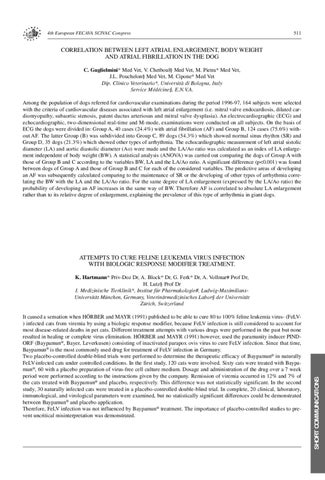4th European FECAVA SCIVAC Congress
511
CORRELATION BETWEEN LEFT ATRIAL ENLARGEMENT, BODY WEIGHT AND ATRIAL FIBRILLATION IN THE DOG C. Guglielmini* Med Vet, V. Chetboul§ Med Vet, M. Pietra* Med Vet, J.L. Pouchelon§ Med Vet, M. Cipone* Med Vet Dip. Clinico Veterinario*, Università di Bologna, Italy Service Médécine§, E.N.V.A. Among the population of dogs referred for cardiovascular examinations during the period 1996-97, 164 subjects were selected with the criteria of cardiovascular diseases associated with left atrial enlargement (i.e. mitral valve endocardiosis, dilated cardiomyopathy, subaortic stenosis, patent ductus arteriosus and mitral valve dysplasia). An electrocardiographic (ECG) and echocardiographic, two-dimensional real-time and M-mode, examinations were conducted on all subjects. On the basis of ECG the dogs were divided in: Group A, 40 cases (24.4%) with atrial fibrillation (AF) and Group B, 124 cases (75.6%) without AF. The latter Group (B) was subdivided into Group C, 89 dogs (54.3%) which showed normal sinus rhythm (SR) and Group D, 35 dogs (21.3%) which showed other types of arrhythmia. The echocardiographic measurement of left atrial sistolic diameter (LA) and aortic diastolic diameter (Ao) were made and the LA/Ao ratio was calculated as an index of LA enlargement independent of body weight (BW). A statistical analysis (ANOVA) was carried out comparing the dogs of Group A with those of Group B and C according to the variables BW, LA and the LA/Ao ratio. A significant difference (p<0.001) was found between dogs of Group A and those of Group B and C for each of the considered variables. The predictive areas of developing an AF was subsequently calculated comparing to the maintenance of SR or the developing of other types of arrhythmia correlating the BW with the LA and the LA/Ao ratio. For the same degree of LA enlargement (expressed by the LA/Ao ratio) the probability of developing an AF increases in the same way of BW. Therefore AF is correlated to absolute LA enlargement rather than to its relative degree of enlargement, explaining the prevalence of this type of arrhythmia in giant dogs.
ATTEMPTS TO CURE FELINE LEUKEMIA VIRUS INFECTION WITH BIOLOGIC RESPONSE MODIFIER TREATMENT.
It caused a sensation when HÖRBER and MAYR (1991) published to be able to cure 80 to 100% feline leukemia virus- (FeLV) infected cats from viremia by using a biologic response modifier, because FeLV infection is still considered to account for most disease-related deaths in pet cats. Different treatment attempts with various drugs were performed in the past but none resulted in healing or complete virus elimination. HÖRBER and MAYR (1991) however, used the paramunity inducer PINDORF (Baypamun®, Bayer, Leverkusen) consisting of inactivated parapox ovis virus to cure FeLV infection. Since that time, Baypamun® is the most commonly used drug for treatment of FeLV infection in Germany. Two placebo-controlled double-blind trials were performed to determine the therapeutic efficacy of Baypamun® in naturally FeLV-infected cats under controlled conditions. In the first study, 120 cats were involved. Sixty cats were treated with Baypamun®, 60 with a placebo preparation of virus-free cell culture medium. Dosage and administration of the drug over a 7 week period were performed according to the instructions given by the company. Remission of viremia occurred in 12% and 7% of the cats treated with Baypamun® and placebo, respectively. This difference was not statistically significant. In the second study, 30 naturally infected cats were treated in a placebo-controlled double-blind trial. In complete, 20 clinical, laboratory, immunological, and virological parameters were examined, but no statistically significant differences could be demonstrated between Baypamun® and placebo application. Therefore, FeLV infection was not influenced by Baypamun® treatment. The importance of placebo-controlled studies to prevent uncritical misinterpretation was demonstrated.
SHORT COMMUNICATIONS
K. Hartmann* Priv-Doz Dr, A. Block* Dr, G. Ferk* Dr, A. Vollmar# Prof Dr, H. Lutz§ Prof Dr I. Medizinische Tierklinik*, Institut für Pharmakologie#, Ludwig-MaximiliansUniversität München, Germany, Veterinärmedizinisches Labor§ der Universität Zürich, Switzerland
